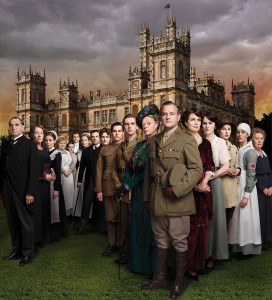 Viewers here and in England have developed a mad crush on Downton Abbey, the plushly produced series about the Crawleys, an aristocratic British family in turmoil over the inheritance of its patrimony, the Earldom of Grantham. The clan and its large staff of household servants is meanwhile caught up in the tumultuous changes that start roiling English society as the placid Edwardian era abruptly ends with the onset of World War I.
Viewers here and in England have developed a mad crush on Downton Abbey, the plushly produced series about the Crawleys, an aristocratic British family in turmoil over the inheritance of its patrimony, the Earldom of Grantham. The clan and its large staff of household servants is meanwhile caught up in the tumultuous changes that start roiling English society as the placid Edwardian era abruptly ends with the onset of World War I.
The show – a Carnival/Masterpiece co-production, in association with NBCUniversal – has turned out to be a ratings smash for public television broadcaster PBS, which airs the one-hour show under its Masterpiece banner. A typical episode draws a larger audience than one of Mad Men.
Downton has received a whole lot of love from Emmy voters as well. When the 2012 Primetime Emmy nominations were announced in July, Downton received 16 nominations for Season 2, which aired early this year. That total is up from the not-so-shabby 11 nominations snagged last year, including six wins.
The nominations run the gamut, from topline categories including best drama series, acting (a total of six noms), writing and directing to nods in five craft categories – best production design, costumes, hair design, sound mixing and music. And much of what appeals to viewers is the show’s overall look, which underpins the superb ensemble acting and Julian Fellow’s scripts.
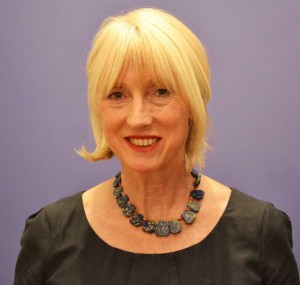
The most important production design decision came early – finding an appropriate country house to be transformed into the fictional Downton Abbey. “It was a bit like casting a main character in the piece. It took a considerable amount of time, effort and thought,” said Woods. “We surveyed online about 100 proper-sized houses all over the U.K, and then we visited about 40 of them.” The final choice was Highclere Castle, high on the list from the beginning, which has since become an icon for the series as a whole.
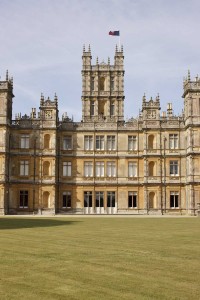
Inside, Highclere has a half-dozen distinctive formal rooms that are already decorated and furnished. “Most of the houses that we looked had rooms that were too much styled the same,” observed Woods. “One of the attributes that attracted us to Highclere is that the rooms are all very different. The main hall has got 17th-century Spanish leather wallpaper. The drawing room has beautiful green silk damask and a very French look, and the library is all brown and gilt and has a very sort of gentleman’s club look.”
Of course, these rooms had to be modified for the shoot. “We replaced about half the furniture and the look of the rooms changed subtly with the passage of time,” he said. For Season 2, the house required much more set dressing than for Season 1. That’s because Downton, as part of the home front during the war, is transformed into a makeshift convalescent home. The library becomes a games room for the officers. The main hall becomes their canteen, and the sumptuous drawing room is packed with beds for the injured.
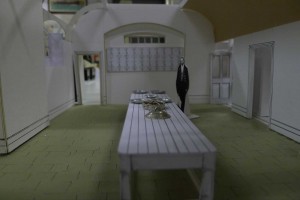
Woods said he decided on a mono-chromatic color scheme for the downstairs to contrast with the aristocratic world upstairs: “We mainly stuck with three colors – creamy white, grey and a darker brown,” he noted. “It was like designing two different films. Whenever the servants go upstairs, it’s a visual slap in the face – all the beautiful gilt and satins and woodwork they are in. We wanted to emphasize the differences between the worlds, but also treat both with respect.”
The cinematography provided its own twist. “We felt we needed to make the upstairs this tranquil, settled picture of English life, at least on the surface, so the camera shots tend to be beautifully framed but static,” Woods said. “The producers, on the other hand said, ‘Let’s make the downstairs look like West Wing – always on the move with lots of energy to it,’ so the camera work was hand held.”
A number of other scenes were also shot on sets built at Ealing. These include the upstairs bedrooms at Downton, where several characters languish after they get the Spanish influenza. The prison where Mr. Bates is jailed is also a set. But Bates’ trial was filmed in an out-of-use courtroom, which had been built originally to resemble No. 1 Old Bailey, London’s most renowned court. “It had pretty much the same wood paneling and a very similar look,” said the production designer.
The beginning of World War I and the fierce hostilities that ensue dominate the first few episodes of Season 2, as Downton heir Matthew Crawley (Dan Stevens) and several male servants enlist. For the battle scenes, replicas of the war’s notorious trenches were discovered on a farm in the east of England. A military historian had designed them for instruction. The detailed trenches stretched some 700 feet and were extended by another 300 feet, an arduous task that took three weeks with another week of set dressing required.
“They were built on very muddy clay soil, which stayed wet and damp the whole time, much to the discomfort of the actors, but wound up looking fantastic,” Woods observed. A decision was made to shoot these scenes at the start of filming Season 2 in February 2011. “That let us capture the gray drizzle and coldness that one associates with the First World War.” Word came that Steven Spielberg’s War Horse, also featuring World War I trenches, was set for release around the same time as Downton Season 2 was about to air. “We were slightly worried, because we didn’t have Spielberg’s millions, but in the end I feel our own trenches did us proud,” Woods declared.
Woods had fulsome praise for the work done by his own team of collaborators, who are fellow-nominees for the production design Emmy: art director Charmian Adams, whose skills included finding the period autos and trains that were prominently featured; and set decorator Judy Farr who had a dozen people in her own crew. Farr was nominated for an Oscar in 2011 for her work on The King’s Speech.
Woods also worked closely with Buxton. A priority was to coordinate colors. “We’d meet up for a coffee or take a lunch and just let it flow just between the two of us,” he recalled. “As a result, downstairs became simpler and simpler, and upstairs, more lavish and complex.”
For the World War I episodes at the start of the second season, Buxton had to come up with a large number of officer uniforms and soldiers’ battlefield outfits. “We made only a few of the military uniforms, and got the rest mainly from Angels, the big London costume house,” said the designer. “We also had a military adviser to make sure they were as accurate as possible.”
Meanwhile, even aristocratic women dressed down. “The clothes look more utilitarian because luxury fabrics were not as available, and it wasn’t considered appropriate to look too showy in public,” noted Buxton. “In terms of fashion, a big change was in the silhouettes, with long thin floor-length gowns giving way to skirts that flared more,” she said. “Ankles were shown for the first time during the war.
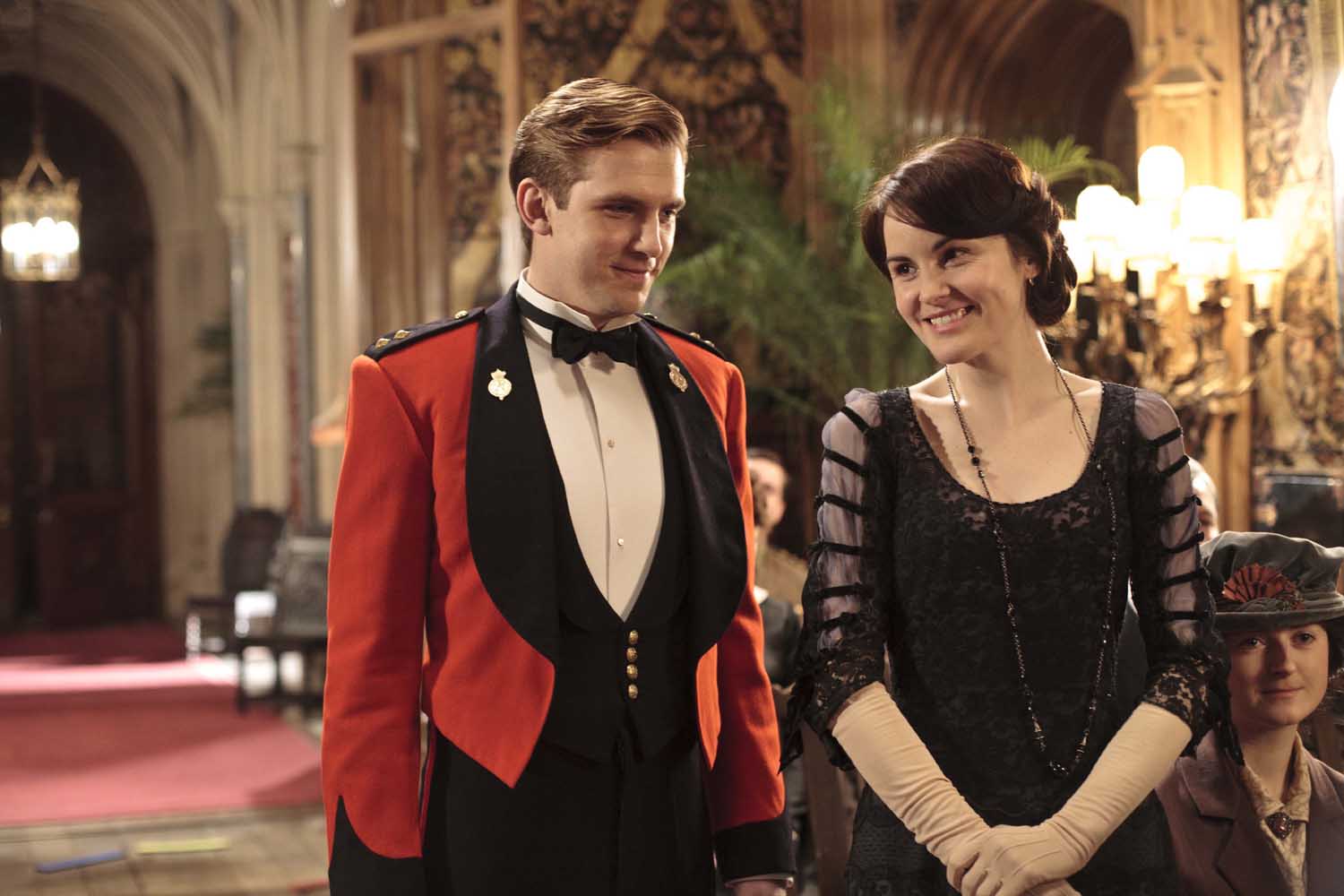
Fancy frocks were not banished entirely in Season 2. Lady Mary, in particular, continues to dazzle at elaborate dinner parties and soirees, which are out of the public eye. Pioneering French fashion designers Paul Poiret and Coco Chanel, who were just coming into their own at the time, influenced Buxton. “I tried to emulate but not duplicate them,” she said. “In the dresses for Michelle I certainly referenced Poiret, who was the first to redesign and relax the corset, making dresses looser and more comfortable.”
Maggie Smith, who plays the acerbic family grande dame, Violet Crawley, the Dower Countess of Grantham, posed a special challenge. “Her character has such a strong personality that it’s a shame to distract from it, so I decided to work with it,” says the costume designer. “She likes to make an impressive entrance so I made sure each time it was also an important costume moment.”
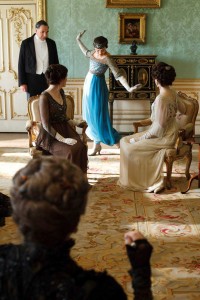 All of Smith’s outfits were handmade in the workrooms at CosProp, another big London costume firm, requiring the services of about a dozen employees. Overall, Buxton had a constant team of six working under her, along with milliners, seamstresses and tailors on hand in the number needed at any time.
All of Smith’s outfits were handmade in the workrooms at CosProp, another big London costume firm, requiring the services of about a dozen employees. Overall, Buxton had a constant team of six working under her, along with milliners, seamstresses and tailors on hand in the number needed at any time.
“My aim is always to create something that makes the person look like he or she is wearing clothes, not wearing costumes,” said Buxton. The virtue of working on a multi-year series is that “you get more time to know a character, and that allows you to build a wardrobe that the character would actually wear,” she noted. She also praised the work of fellow Emmy nominees Ann “Nosh” Oldham, who did the hair and makeup and key hair stylist Christine Greenword, for also filling out the personalities of the characters.
With all the show’s demands, Buxton said she had “a very tight budget” to work with. “Everyone thinks I had carte blanche but that is far from the truth.” Buxton’s apparel for Downton Abbey has already had an impact on contemporary fashion. Vogue in this country and Love in Great Britain have done features on the actresses who play the three Crawley daughters. “Long white gloves and costume jewelry have also become more popular,” the costume designer observed.
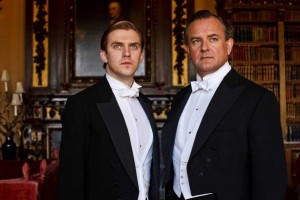
Woods continues as production designer for Season 3. He managed to fit in work on one film, My Week With Marilyn, about a budding romance between a production assistant and Marilyn Monroe. Otherwise he’s been immersed in his work on Downton Abbey. Season 3 is in the final stages of filming. It will be debut this fall in England and will be seen here next January.
Anticipation for Season 3 has been ramping up. A few details have begun to leak out. Shirley MacLaine joins the cast as Cora’s American mother and she will be crossing swords with Maggie Smith’s Violet. “But even though we move into the first years of the Roaring Twenties in the plot,” said Woods, “most of the action will continue to be centered at Downton.”





